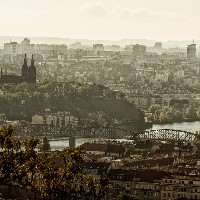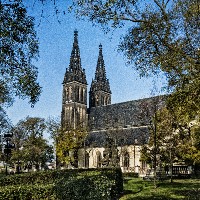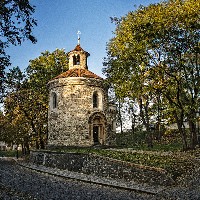Breadcrumbs navigation
Vyšehrad - The seat of the first Czech King
This other Prague castle, dominant above the confluence of the Vltava River and the Botič stream is one of the most memorable places of Czech history, its mystery underscored by popular myths and legends. Its present-day ambience – hallowed and at the same time relaxed – is enhanced by a raft of remarkable monuments and a plethora of cultural goings-on within its walls, mainly in the summer months. Although Vyšehrad in the 21st century remains a symbol of national identity, it also offers topical social and educative experiences, as well as a fine place to relax and enjoy some quiet reflection. Let us take you on a stroll through the history and highlights of the Vyšehrad stronghold.
A brief history of Vyšehrad
According to the latest research, Vyšehrad was established in the latter half of the 10th century, about a hundred years after Prague Castle. It flourished in the early Middle Ages, in the last third of the 11th and first half of the 12th century, when it rivalled and for a while even outshone Prague Castle in its grandeur. This was all down to prince and first Czech King Vratislav II (ruled 1061-1092), who like several of his immediate successors chose the Vyšehrad clifftop for his fortified royal headquarters and the main Přemyslid dynastic seat. The earliest stone buildings date from this period. The coronation of Vladislav II in 1140 put Prague Castle back in favour. Vyšehrad’s star rose again with Czech King and Roman Emperor Charles IV (ruled 1346-1378), and his avowed Přemyslid lineage. A magnificent reconstruction, following-on from the founding of the New Town of Prague, made Vyšehrad Castle a prime palatial edifice with an important role in Czech coronations.
During the Hussite wars the castle was plundered and destroyed. Its walls also suffered in the double besieging of Prague by the Swedes in 1639 and 1648. The faded glory of the Royal residence was restored only in the second half of the 17th century, turning it into a Baroque military fortress. This construction work gave Vyšehrad its current citadel layout, with its mighty brick ramparts and the imposing Leopold gate. The 19th century changed the character of Vyšehrad by adding the Slavín cemetery for the nation’s greats, and the neo-Gothic Basilica of St Peter and Paul. Its more than millennial history was topped off with a renewal of its vineyards, and extensive landscaping. The overall atmosphere is complemented by magnificent views from the Baroque fortifications, made accessible as an all-round walkway.
![]() For more information about Vyšehrad castle, visit
For more information about Vyšehrad castle, visit ![]() praha-vysehrad.cz.
praha-vysehrad.cz.
Not to be missed:
Špička (Peak) Gate
The entrance tower from the time of Charles IV, originally half-timbered with slender bay-turrets. All that remains of this monumental building is the torso of the lower part of the portals and the ground-floor room.
Leopold Gate
This architecturally pure early-Baroque gate has a decorative gable-end with cornices bearing stone decorations, two lions couchant and three coats of arms, all of sandstone. Crowning the assembly is a she-eagle.
St Martin Rotunda
The oldest building not just within the fortress, but probably Prague itself. This church has seen it all – serving as a gunpowder store, a warehouse or a pauper shelter. It owes its appearance today to restoration at the end of the 19th century.
Devil’s Pillar
Vyšehrad’s riddle and curiosity. These three abutting pillar segments of uncertain origin and purpose are the stuff of many legends; in the Karlachovy sady park.
Romanesque bridge
The connection between the royal residence in the southwest part of the complex and the ecclesiastical section around the Basilica of St Peter and Paul was via a remarkable Romanesque bridge, part of which is now accessible.
Basilica of Sts Peter and Paul
The initially Romanesque, then Gothic, Renaissance, Baroque, and finally neo-Gothic landmark of Vyšehrad. When founded, the church got its own collegiate chapter.
Vyšehrad Cemetery and Slavín
This most significant Prague cemetery remembers 600 leading Czech celebrities, among them the composers Bedřich Smetana and Antonín Dvořák and the writers Karel Čapek and Jan Neruda. Also on this memorial site is the monumental Slavín tomb – the shared final resting place of the nation’s greats.
Myslbek’s statues
You will find this grouping of four wonderful statues in the Vyšehrad park in front of the Basilica. The sculptures depict scenes from old Czech lore, featuring figures such as Přemysl & Libuše or Ctirad & Šárka.
Old Burgrave’s House
One of the palace buildings from the 14th century, now serving as a hall for 90 visitors, and a café. A popular weekend venue for kids’ cultural programmes.
Gothic cellars
A large subterranean space under one of the four Charles IV palace buildings. Inside you can view a spectacular exhibition on Vyšehrad down the ages.
Galerie Vyšehrad
A venue regularly presenting upcoming and recently established artists, focused mainly on painting, drawing and the like arts. The building is what remains of one of the medieval fortification guard towers.
St Wenceslas Statue
In the Štulcovy sady park is a copy of the 17th century equestrian statue of St Wenceslas that stood at the top end of Wenceslas Square until replaced by the present monument in 1879. The original is currently on display at the National Lapidary Museum.
Brick Gate
The northern entrance to the fortress was built in the Empire style in 1841, to go with the new encampment road. Today, it houses the information centre and is way in to the casemates, showing multimedia projections on Vyšehrad.
Casemates and the Gorlice
An intricate complex of underground passages, from the 17th and 18th century, built as part of the Baroque ramparts fortification. The largest, called the Gorlice, houses six original sculptures off the Charles Bridge.
Cultural and other sightseeing in the area:
Cubist housing![]() Libušina 3, Neklanova 30, Rašínovo nábřeží 6-10
Libušina 3, Neklanova 30, Rašínovo nábřeží 6-10
Of Europe-wide significance – a unique set of Cubist homes by architect Josef Chochola. Among them, the Kovařovicova villa, a corner apartment house and a triad of terraced homes on the waterfront.
The City of Prague Museum – Podskalská Customs Office![]() Rašínovo nábřeží 30
Rašínovo nábřeží 30 ![]() muzeumprahy.cz
muzeumprahy.cz
A part-interactive exhibit in a historic building from the 16th century focused on the erstwhile Podskalí zone, the transformation of water transport along the Vltava River, from traditional loggers’ rafts to shipping in and around Prague.
Prague Waterworks Museum in Podolí![]() Podolská 15/17
Podolská 15/17 ![]() pvk.cz
pvk.cz
The Prague Waterworks is a listed industrial heritage building. From its 40-metre-high observation deck it offers a remarkable view of the river and the city. The museum charts the development of Prague waterworks from the 12th century to now.
A break for coffee, lunch or dinner:
U Kroka![]() Vratislavova 28
Vratislavova 28 ![]() ukroka.cz
ukroka.cz
This family restaurant continues the tradition of the renowned Prague inn that opened along the cruise route to Vyšehrad castle back in 1895. It boasts a grand ambience, quality Czech cuisine and upmarket beers on tap.
Rio’s Vyšehrad ![]() NKP Vyšehrad
NKP Vyšehrad ![]() riorestaurant.cz
riorestaurant.cz
The restaurant is just the deal for private parties, wedding receptions and press conferences. You can sample its vaunted cuisine by way of a sumptuous dinner or long lunch; for speedier and smaller dishes, head for the café upstairs.
How to get there
Metro Line C, Vyšehrad
Tram 7, 14, 18, 24, 95-93, – to Albertov
Tram 2, 3, 7, 17, 21, 92 – to Výtoň
Author: Jan Pomykal - Web Content and Publishing Department



